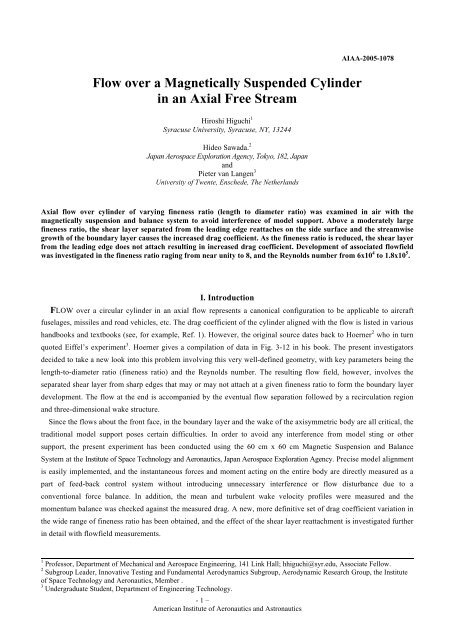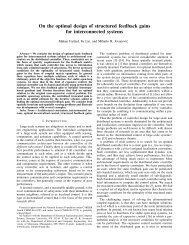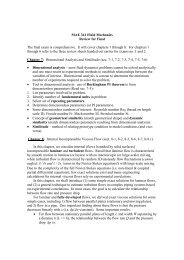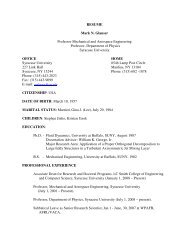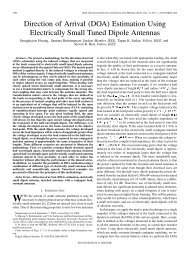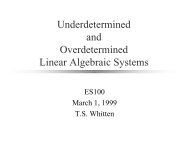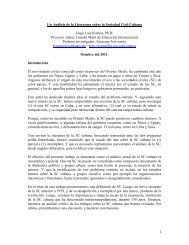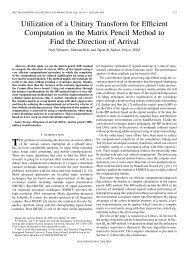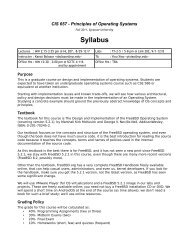Flow over a Magnetically Suspended Cylinder in an Axial Free Stream
Flow over a Magnetically Suspended Cylinder in an Axial Free Stream
Flow over a Magnetically Suspended Cylinder in an Axial Free Stream
You also want an ePaper? Increase the reach of your titles
YUMPU automatically turns print PDFs into web optimized ePapers that Google loves.
<strong>Flow</strong> <strong>over</strong> a <strong>Magnetically</strong> <strong>Suspended</strong> <strong>Cyl<strong>in</strong>der</strong><br />
<strong>in</strong> <strong>an</strong> <strong>Axial</strong> <strong>Free</strong> <strong>Stream</strong><br />
Hiroshi Higuchi 1<br />
Syracuse University, Syracuse, NY, 13244<br />
Hideo Sawada. 2<br />
Jap<strong>an</strong> Aerospace Exploration Agency, Tokyo, 182, Jap<strong>an</strong><br />
<strong>an</strong>d<br />
Pieter v<strong>an</strong> L<strong>an</strong>gen 3<br />
University of Twente, Enschede, The Netherl<strong>an</strong>ds<br />
AIAA-2005-1078<br />
<strong>Axial</strong> flow <strong>over</strong> cyl<strong>in</strong>der of vary<strong>in</strong>g f<strong>in</strong>eness ratio (length to diameter ratio) was exam<strong>in</strong>ed <strong>in</strong> air with the<br />
magnetically suspension <strong>an</strong>d bal<strong>an</strong>ce system to avoid <strong>in</strong>terference of model support. Above a moderately large<br />
f<strong>in</strong>eness ratio, the shear layer separated from the lead<strong>in</strong>g edge reattaches on the side surface <strong>an</strong>d the streamwise<br />
growth of the boundary layer causes the <strong>in</strong>creased drag coefficient. As the f<strong>in</strong>eness ratio is reduced, the shear layer<br />
from the lead<strong>in</strong>g edge does not attach result<strong>in</strong>g <strong>in</strong> <strong>in</strong>creased drag coefficient. Development of associated flowfield<br />
was <strong>in</strong>vestigated <strong>in</strong> the f<strong>in</strong>eness ratio rag<strong>in</strong>g from near unity to 8, <strong>an</strong>d the Reynolds number from 6x10 4 to 1.8x10 5 .<br />
I. Introduction<br />
FLOW <strong>over</strong> a circular cyl<strong>in</strong>der <strong>in</strong> <strong>an</strong> axial flow represents a c<strong>an</strong>onical configuration to be applicable to aircraft<br />
fuselages, missiles <strong>an</strong>d road vehicles, etc. The drag coefficient of the cyl<strong>in</strong>der aligned with the flow is listed <strong>in</strong> various<br />
h<strong>an</strong>dbooks <strong>an</strong>d textbooks (see, for example, Ref. 1). However, the orig<strong>in</strong>al source dates back to Hoerner 2 who <strong>in</strong> turn<br />
quoted Eiffel’s experiment 3 . Hoerner gives a compilation of data <strong>in</strong> Fig. 3-12 <strong>in</strong> his book. The present <strong>in</strong>vestigators<br />
decided to take a new look <strong>in</strong>to this problem <strong>in</strong>volv<strong>in</strong>g this very well-def<strong>in</strong>ed geometry, with key parameters be<strong>in</strong>g the<br />
length-to-diameter ratio (f<strong>in</strong>eness ratio) <strong>an</strong>d the Reynolds number. The result<strong>in</strong>g flow field, however, <strong>in</strong>volves the<br />
separated shear layer from sharp edges that may or may not attach at a given f<strong>in</strong>eness ratio to form the boundary layer<br />
development. The flow at the end is accomp<strong>an</strong>ied by the eventual flow separation followed by a recirculation region<br />
<strong>an</strong>d three-dimensional wake structure.<br />
S<strong>in</strong>ce the flows about the front face, <strong>in</strong> the boundary layer <strong>an</strong>d the wake of the axisymmetric body are all critical, the<br />
traditional model support poses certa<strong>in</strong> difficulties. In order to avoid <strong>an</strong>y <strong>in</strong>terference from model st<strong>in</strong>g or other<br />
support, the present experiment has been conducted us<strong>in</strong>g the 60 cm x 60 cm Magnetic Suspension <strong>an</strong>d Bal<strong>an</strong>ce<br />
System at the Institute of Space Technology <strong>an</strong>d Aeronautics, Jap<strong>an</strong> Aerospace Exploration Agency. Precise model alignment<br />
is easily implemented, <strong>an</strong>d the <strong>in</strong>st<strong>an</strong>t<strong>an</strong>eous forces <strong>an</strong>d moment act<strong>in</strong>g on the entire body are directly measured as a<br />
part of feed-back control system without <strong>in</strong>troduc<strong>in</strong>g unnecessary <strong>in</strong>terference or flow disturb<strong>an</strong>ce due to a<br />
conventional force bal<strong>an</strong>ce. In addition, the me<strong>an</strong> <strong>an</strong>d turbulent wake velocity profiles were measured <strong>an</strong>d the<br />
momentum bal<strong>an</strong>ce was checked aga<strong>in</strong>st the measured drag. A new, more def<strong>in</strong>itive set of drag coefficient variation <strong>in</strong><br />
the wide r<strong>an</strong>ge of f<strong>in</strong>eness ratio has been obta<strong>in</strong>ed, <strong>an</strong>d the effect of the shear layer reattachment is <strong>in</strong>vestigated further<br />
<strong>in</strong> detail with flowfield measurements.<br />
1 Professor, Department of Mech<strong>an</strong>ical <strong>an</strong>d Aerospace Eng<strong>in</strong>eer<strong>in</strong>g, 141 L<strong>in</strong>k Hall; hhiguchi@syr.edu, Associate Fellow.<br />
2 Subgroup Leader, Innovative Test<strong>in</strong>g <strong>an</strong>d Fundamental Aerodynamics Subgroup, Aerodynamic Research Group, the Institute<br />
of Space Technology <strong>an</strong>d Aeronautics, Member .<br />
3 Undergraduate Student, Department of Eng<strong>in</strong>eer<strong>in</strong>g Technology.<br />
- 1 –<br />
Americ<strong>an</strong> Institute of Aeronautics <strong>an</strong>d Astronautics
II. Experimental Set Up<br />
A. Magnetic Model Suspension, Force Bal<strong>an</strong>ce <strong>an</strong>d W<strong>in</strong>d Tunnel<br />
The experiment was conducted us<strong>in</strong>g the Magnetic Suspension <strong>an</strong>d Bal<strong>an</strong>ce System at the Institute of Space<br />
Technology <strong>an</strong>d Aeronautics, Jap<strong>an</strong> Aerospace Exploration Agency (formerly the National Aerospace Laboratory). The system<br />
was developed by the second author <strong>an</strong>d is described <strong>in</strong> Ref. 4. Figure 1 shows schematically the coil arr<strong>an</strong>gement used<br />
<strong>in</strong> the system, <strong>an</strong>d specifications of the <strong>in</strong>dividual coils are listed <strong>in</strong> Table 1. The position <strong>an</strong>d attitude of the model<br />
were monitored by two CCD cameras oriented perpendicular to each other. Two colors <strong>an</strong>d filters were used to<br />
separate reflected lights <strong>in</strong> two directions. The position was controlled at a feedback frequency of 248Hz. The magnet<br />
current was calibrated aga<strong>in</strong>st known force applied through pulleys <strong>an</strong>d weights for each model. The calibration was<br />
repeatable with<strong>in</strong> 0.02%. The models were made of alum<strong>in</strong>um alloy <strong>an</strong>d housed a rod-shaped magnet along their<br />
centerl<strong>in</strong>e. The bal<strong>an</strong>ce system was <strong>in</strong>stalled <strong>in</strong> the subsonic w<strong>in</strong>d tunnel with a 60cmx60cm test section. The available<br />
flow speed r<strong>an</strong>ges from 10 to 35 m/s. The free stream turbulence level was less th<strong>an</strong> 0.05%. The measured flow <strong>an</strong>gle<br />
at the center is 0.05 degree <strong>in</strong> downwash <strong>an</strong>d 0.15 degree about z-axis shown <strong>in</strong> Fig. 1. Further detail of the MSBS <strong>an</strong>d<br />
the w<strong>in</strong>d tunnel c<strong>an</strong> be found <strong>in</strong> Ref. 4.<br />
model<br />
coil # turn number size purposes<br />
0,9 50 620 x 620 drag<br />
1,3,5,7 97 + 97 200 x 200 lift,<br />
pitch moment<br />
side force ,<br />
yaw<strong>in</strong>g moment,<br />
roll<strong>in</strong>g moment<br />
130V, 120A <strong>in</strong> cont<strong>in</strong>uous mode … 3 units<br />
130V, 60A <strong>in</strong> cont<strong>in</strong>uous mode … 4 units<br />
5 DOF for models with a ma<strong>in</strong> magnet only<br />
6 DOF for special models with pair magnets<br />
2,4,6,8 100 200 x 200<br />
coil drive<br />
units<br />
control<br />
Table 1 Specifications of the 60cm MSBS (Ref. 4)<br />
position sens<strong>in</strong>g camera<br />
Fig. 1 MSBS coil arr<strong>an</strong>gement (not to scale,<br />
only one camera is shown)<br />
B. Test Models<br />
Figures 2 illustrates cyl<strong>in</strong>drical models supported magnetically <strong>in</strong> the test section. In addition to the model edges, the<br />
sens<strong>in</strong>g cameras use a vertical stripe <strong>in</strong> the middle to detect the model position <strong>an</strong>d attitude. Inst<strong>an</strong>t<strong>an</strong>eous model position<br />
was monitored <strong>an</strong>d held with<strong>in</strong> ±0.2mm. In order to provide a wide r<strong>an</strong>ge of the f<strong>in</strong>eness ratio, models with different<br />
diameters were used. One had 45mm diameter <strong>an</strong>d shared the same center section enclos<strong>in</strong>g the magnet. By ch<strong>an</strong>g<strong>in</strong>g the end<br />
caps of different lengths, n<strong>in</strong>e f<strong>in</strong>eness ratios between 4.13 <strong>an</strong>d 8.13 were achieved. Second set of model had a diameter of<br />
85mm <strong>an</strong>d the third 110mm. These larger diameter models provided the f<strong>in</strong>eness ratio down to 1.272. An additional model of<br />
25mm diameter <strong>an</strong>d f<strong>in</strong>eness ratio of 6 was also used. The Reynolds number based on the diameter r<strong>an</strong>ged from 60,000 to<br />
100,000.<br />
- 2 –<br />
Americ<strong>an</strong> Institute of Aeronautics <strong>an</strong>d Astronautics
Fig. 2(a) A magnetically supported 45mm diameter cyl<strong>in</strong>der model<br />
Fig. 2(b) A magnetically supported 85mm diameter cyl<strong>in</strong>der model<br />
III. Results <strong>an</strong>d Discussion<br />
A. Wake beh<strong>in</strong>d magnetically supported cyl<strong>in</strong>der<br />
The me<strong>an</strong> velocity distribution beh<strong>in</strong>d the L/D=5.02 model is presented <strong>in</strong> both vertical (z) <strong>an</strong>d horizontal (y)<br />
directions <strong>in</strong> Fig. 3. The dist<strong>an</strong>ce is measured from the trail<strong>in</strong>g edge of the model. An earlier test employed the PIV<br />
system on lo<strong>an</strong> <strong>an</strong>d the results <strong>in</strong>dicated excellent results <strong>in</strong> the wake while limit<strong>in</strong>g the illum<strong>in</strong>ation away from the<br />
position sens<strong>in</strong>g cameras. Results from <strong>an</strong>other PIV measurement <strong>in</strong> water will be also discussed oater. However, these<br />
velocity measurements relied on a more conventional total head probe as well as a hot-wire probe. Naturally, the<br />
results are limited to regions where these <strong>in</strong>strumentations are applicable. Figure 3 nonetheless demonstrates excellent<br />
flow axisymmetry measured with the total head probe. The results clearly benefited from the absence of the model<br />
support <strong>in</strong> the present system. The symmetry of the flow <strong>an</strong>d the repeatability of the measurements are further<br />
illustrated <strong>in</strong> Fig. 4 by vertical <strong>an</strong>d horizontal probe traverses.<br />
- 3 –<br />
Americ<strong>an</strong> Institute of Aeronautics <strong>an</strong>d Astronautics
80<br />
u/U<br />
65<br />
50<br />
35<br />
20<br />
5<br />
z(mm)<br />
-10<br />
-25<br />
-40<br />
-55<br />
-70<br />
1.00 -1.02<br />
0.98 -1.00<br />
0.96 -0.98<br />
0.94 -0.96<br />
0.92 -0.94<br />
0.90 -0.92<br />
0.88 -0.90<br />
0.86 -0.88<br />
0.84 -0.86<br />
0.82 -0.84<br />
0.80 -0.82<br />
-85<br />
-70<br />
-55<br />
-40<br />
-25<br />
-10<br />
5<br />
20<br />
35<br />
50<br />
65<br />
80<br />
-85<br />
y(mm)<br />
Figure 3 Me<strong>an</strong> axial velocity (u/U) distribution <strong>in</strong> the wake of the 45mm diameter cyl<strong>in</strong>der,<br />
L/D=5.02 at x/D= 6.11 (Re D =100,000)<br />
1.05<br />
1.00<br />
0.95<br />
y traverse<br />
y traverse (mirror image)<br />
z traverse (mirror image)<br />
z traverse<br />
u/U<br />
0.90<br />
0.85<br />
0.80<br />
-2.0 -1.5 -1.0 -0.5 0.0 0.5 1.0 1.5 2.0<br />
y/D or z/D<br />
Figure 4 Me<strong>an</strong> velocity profiles along 2 axes <strong>in</strong> the wake<br />
a 45mm diameter L/D=5.02 axial cyl<strong>in</strong>der at x/D= 6.11<br />
The streamwise variation of the me<strong>an</strong> velocity <strong>in</strong> the wake was measured beh<strong>in</strong>d the 25mm diameter cyl<strong>in</strong>der<br />
with a s<strong>in</strong>gle hot wire probe, <strong>an</strong>d the results are shown <strong>in</strong> Fig. 5. When the virtual orig<strong>in</strong> of the wake was taken to be<br />
1.3D downstream of the trail<strong>in</strong>g edge, the velocity defects shown <strong>in</strong> Figs. 4 <strong>an</strong>d 5 followed the established x^(-1/3)<br />
law for axisymmetric wakes.<br />
1.0<br />
u/Uma<strong>in</strong><br />
0.8<br />
0.6<br />
0.4<br />
z=1mm<br />
x=0.04D<br />
x=2D<br />
x=4D<br />
x=10D<br />
0.2<br />
0.0<br />
-2.0 -1.5 -1.0 -0.5 0.0 0.5 1.0 1.5 2.0<br />
y/D<br />
Figure 5.<br />
Velocity distributions across the wake of 25mm diameter cyl<strong>in</strong>der (L/D=6)<br />
- 4 –<br />
Americ<strong>an</strong> Institute of Aeronautics <strong>an</strong>d Astronautics
(y - D/2)/delta<br />
2.0<br />
1.5<br />
1.0<br />
0.5<br />
L/D=4.13 (45Dia.) delta=32.5mm<br />
L/D=5.02 (45Dia.) delta=32.5mm<br />
L/D=6.00 (25Dia.) delta=19.0mm<br />
L/D=8.13 (45Dia.) delta=41.0mm<br />
0.2<br />
0.0<br />
0 0 0 0 1 1 1 1<br />
u/U<br />
Figure 6. u/U vs.[y-(D/2)]/δ, effect of f<strong>in</strong>eness ratio)<br />
(Re D =50,000 for 25mm dia, 100,000 for 45mm dia.)<br />
2.0<br />
1.5<br />
L/D=4.13 (45Dia.) delta=32.5mm<br />
L/D=5.02 (45Dia.) delta=32.5mm<br />
L/D=6.00 (25Dia.) delta=19.0mm<br />
L/D=8.13 (45Dia.) delta=41.0mm<br />
(y - D/2)/delta<br />
1.0<br />
0.2<br />
0.5<br />
0.0<br />
0 0 0 0<br />
0.8<br />
u rms /U<br />
Figure 7. u rms /U vs. .[y-(D/2)]/δ, effect of f<strong>in</strong>eness ratio<br />
The boundary layer leav<strong>in</strong>g the cyl<strong>in</strong>der at the trail<strong>in</strong>g edge was further <strong>in</strong>vestigated for various f<strong>in</strong>eness ratios.<br />
The me<strong>an</strong> velocity profiles <strong>an</strong>d the turbulence <strong>in</strong>tensity normalizes by the boundary layer thickness are shown <strong>in</strong> Fig.<br />
6 <strong>an</strong>d Fig. 9, respectively. Ota 4 <strong>in</strong>vestigated the boundary layer <strong>over</strong> a st<strong>in</strong>g-mounted sharp-edged cyl<strong>in</strong>der, <strong>an</strong>d his<br />
velocity profiles at x/D=3.1, 5.1, <strong>an</strong>d 7.1 from the lead<strong>in</strong>g edge are very consistent with the present data at the<br />
trail<strong>in</strong>g edge (L/D=4.13-8.13). Ota’s experiment corresponds to Re D =5.62x10 4 <strong>an</strong>d the Reynolds number for the<br />
measurements <strong>in</strong> Figs. 6 <strong>an</strong>d 7 was 5x10 4 for the 25mm cyl<strong>in</strong>der <strong>an</strong>d 1x10 5 for the 45mm cyl<strong>in</strong>der. The oil flow<br />
visualization <strong>an</strong>d Ota’s measurement <strong>in</strong>dicated a separation bubble from the lead<strong>in</strong>g edge end<strong>in</strong>g with flow<br />
reattachment approximately at 1.5-1.6 diameter downstream. The me<strong>an</strong> velocity profiles further downstream of the<br />
reattachment are <strong>in</strong>dicative of a develop<strong>in</strong>g turbulent boundary layer. The turbulent <strong>in</strong>tensity profiles are also <strong>in</strong><br />
general agreement between the two experiments, though the present data are at a somewhat higher level. The power<br />
spectrum density <strong>in</strong> the immediate wake shear layer showed the distribution typical of turbulent boundary layer<br />
devoid of <strong>an</strong>y spectral peak, but at x/D=4, a spectral peak was evident at Strouhal number fD/U=0.185 which was<br />
<strong>in</strong>dicative of a helical mode wake oscillation.<br />
C. Force Measurement<br />
The magnetic bal<strong>an</strong>ce was calibrated aga<strong>in</strong>st the known weight for each model. The uncerta<strong>in</strong>ty of the drag<br />
coefficient measurement at Reynolds number 10 5 , for example, was estimated to be ±0.005.<br />
- 5 –<br />
Americ<strong>an</strong> Institute of Aeronautics <strong>an</strong>d Astronautics
1.00<br />
0.95<br />
L/D = 4.13<br />
L/D = 6.13<br />
L/D = 8.13<br />
CD<br />
0.90<br />
0.85<br />
0.80<br />
0.05 0.06 0.07 0.08 0.09 0.10 0.11 0.12<br />
Reynolds number (million)<br />
Fig. 8<br />
Drag coefficient versus Reynolds number at 3 large f<strong>in</strong>eness ratios.<br />
Figure 8 shows that the measured drag coefficients for 3 f<strong>in</strong>eness ratios are nearly const<strong>an</strong>t <strong>over</strong> the r<strong>an</strong>ge of Reynolds<br />
number between 60,000 <strong>an</strong>d 100,000. On the other h<strong>an</strong>d, the f<strong>in</strong>eness ratio has shown a clear <strong>in</strong>fluence on the drag<br />
coefficient as shown at the top of Fig. 9. In order to estimate the contributions to the total drag from the front face pressure,<br />
the base pressure <strong>an</strong>d the boundary layer drag, Fig. 9 shows the total drag, the momentum loss based on the boundary layer<br />
measurement (see Fig 7), <strong>an</strong>d the estimated sk<strong>in</strong> friction drag. The sk<strong>in</strong> friction drag was simply estimated from the empirical<br />
formula for the flat plate turbulent boundary layer (1/5 th power to the Reynolds number based on the length.) Here, the<br />
separated flow at the front corner is considered to attach at 1.5 diameter downstream, based on the oil flow visualization,<br />
which is consistent with Ota’s observation 5 . The differences among the three l<strong>in</strong>es are, <strong>in</strong> effect, estimates of the front<br />
pressure <strong>an</strong>d the base pressure, respectively, <strong>an</strong>d they are nearly <strong>in</strong>dependent of the f<strong>in</strong>eness ratio.<br />
1.0<br />
total drag (measured)<br />
CD based on momentaum thickness<br />
friction drag<br />
0.8<br />
C D = 0.0182(L/D) + 0.7809<br />
base drag<br />
0.6<br />
C D<br />
0.4<br />
C D = 0.0197(L/D) + 0.4331<br />
forebody pressure drag<br />
0.2<br />
0.0<br />
Fig. 9.<br />
C D = 0.0167 (L/D) - 0.0071<br />
friction drag<br />
0 1 2 3 4 5 6 7 8<br />
L/D<br />
Drag coefficient based on momentum thickness versus f<strong>in</strong>eness ratio<br />
(simple l<strong>in</strong>e fit is also given.)<br />
9<br />
Figure 10 summarizes the present measurements <strong>an</strong>d historical as well as classical data. The first experiment by<br />
Eiffel 5 was conducted by dropp<strong>in</strong>g the test models from the Eiffel tower along a guide cable. The second Eiffel data 3<br />
were collected <strong>in</strong> his w<strong>in</strong>d tunnel with models cable-mounted <strong>in</strong> the test section. Apparently Hoerner used Eiffel’s<br />
second data (not as listed <strong>in</strong> his book) <strong>an</strong>d subtracted the estimated sk<strong>in</strong> friction <strong>an</strong>d presented the data. It is of <strong>in</strong>terest<br />
that these Hoerner’s data have been quoted for m<strong>an</strong>y decades <strong>in</strong> m<strong>an</strong>y articles, reference books <strong>an</strong>d textbooks, not<br />
necessarily after critical evaluation. Robertson et al. 7 carried out new w<strong>in</strong>d tunnel measurements to study the effect of<br />
- 6 –<br />
Americ<strong>an</strong> Institute of Aeronautics <strong>an</strong>d Astronautics
1.2<br />
1.1<br />
1.0<br />
Eiffel 1913 (30cm Dia.)<br />
Eiffel 1913 (15cm Dia.)<br />
Roberson<br />
JAXA/NAL(45Dia)<br />
JAXA(85Dia)<br />
JAXA(110Dia)<br />
Cd<br />
0.9<br />
0.8<br />
0.7<br />
0.6<br />
0 1 2 3 4 5 6 7 8 9<br />
L/D<br />
Fig. 10. Drag coefficient variations with f<strong>in</strong>eness ratio (The present data are all at Re D =1x10 5 )<br />
the free stream turbulence on the flow reattachment <strong>an</strong>d the drag at small f<strong>in</strong>eness ratios. Orig<strong>in</strong>al technical results are<br />
given, for example <strong>in</strong> Ref. 7, but summary of data is listed <strong>in</strong> Roberson <strong>an</strong>d Crowe’s textbook 8 for Re D >10 4 are used <strong>in</strong><br />
this figure. The present series of experiment are expected to provide modern, more def<strong>in</strong>itive results on how the<br />
flowfield <strong>an</strong>d drag vary with the wide r<strong>an</strong>ge of f<strong>in</strong>eness ratio.<br />
D. Discussion of results <strong>an</strong>d additional flowfield measurement <strong>in</strong> water.<br />
The lower drag coefficients obta<strong>in</strong>ed <strong>in</strong> the f<strong>in</strong>eness ratio L/D=1-2 is expected to represent flow reattachment on the<br />
side surface. Oil flow visualization was conducted on the long magnetic suspended model of the 45 mm diameter. The<br />
reattachment l<strong>in</strong>e was located near 1.6-1.7 diameters downstream of the lead<strong>in</strong>g edge. In order to obta<strong>in</strong> better<br />
ascerta<strong>in</strong> the flowfield, <strong>an</strong> additional set of experiment was conducted <strong>in</strong> a Syracuse University water ch<strong>an</strong>nel. In lieu<br />
of the magnetic suspension system, the model was st<strong>in</strong>g-mounted from downstream. The st<strong>in</strong>g diameter was kept small<br />
(635mm) compared to the model diameter of 77mm. The cross-flow strut was also kept sufficiently far downstream.<br />
The velocity vector field was measured us<strong>in</strong>g a DANTEC particle image velocimeter (PIV) system at reduced<br />
Reynolds number between 10,000 <strong>an</strong>d 30,000. Seed<strong>in</strong>g was provided by 20µm PSP particles uniformly mixed <strong>in</strong> the<br />
flow. Figure 11 shows the me<strong>an</strong> velocity vector field together with a short model of the f<strong>in</strong>eness ratio of 0.67. One c<strong>an</strong><br />
clearly see that the separat<strong>in</strong>g shear layer rema<strong>in</strong>s separated form<strong>in</strong>g a large reverse flow region <strong>in</strong> the wake. Figure 12<br />
on the other h<strong>an</strong>d shows the me<strong>an</strong> velocity vector past a long cyl<strong>in</strong>der of L/D=3. The separat<strong>in</strong>g <strong>an</strong>d reattach<strong>in</strong>g shear<br />
layer <strong>an</strong>d the recirculat<strong>in</strong>g flow with<strong>in</strong> the separation bubble are clearly seen <strong>in</strong> the measurement. Even though Ota<br />
used the hot wire <strong>an</strong>emometer on a rear-mounted cyl<strong>in</strong>drical model <strong>an</strong>d its use <strong>in</strong> the vic<strong>in</strong>ity of this type of separat<strong>in</strong>g<br />
flow may be of suspect, the deduced streaml<strong>in</strong>es <strong>an</strong>d the location of the flow reattachment are <strong>in</strong> very good agreement<br />
with the current PIV measurement. The behavior of the boundary layer development subsequent to the flow<br />
reattachment <strong>an</strong>d the drag variation with the f<strong>in</strong>eness ratio are <strong>in</strong> accord<strong>an</strong>ce with the velocity profile measurement <strong>in</strong><br />
Fig. 7 <strong>an</strong>d Fig. 10, respectively. At <strong>an</strong> <strong>in</strong>termediate f<strong>in</strong>eness, L/D=1.5, the time averaged separated shear layer attached<br />
<strong>in</strong> the immediate vic<strong>in</strong>ity of the trail<strong>in</strong>g edge as shown <strong>in</strong> Fig. 13. At higher Reynods number of 20,000 <strong>an</strong>d 30,000, the<br />
shear layer was found to attach slightly upstream, <strong>in</strong>dicat<strong>in</strong>g the higher sensitivity to the Reynolds number. This is<br />
close to the region where the drag coefficient reaches its m<strong>in</strong>imum with respect to the f<strong>in</strong>eness ration as shown <strong>in</strong> Fig.<br />
- 7 –<br />
Americ<strong>an</strong> Institute of Aeronautics <strong>an</strong>d Astronautics
10. Roberson et al 7 applied as high as 10% free stream turbulence <strong>an</strong>d observed the reduction of drag due to earlier<br />
reattachment of separated shear layer at L/D=1. Koenig <strong>an</strong>d Roshko 9 placed a disk ahead of the cyl<strong>in</strong>der to control the<br />
separat<strong>in</strong>g shear layer <strong>an</strong>d reattachment. Prelim<strong>in</strong>ary numerical simulations with the implicit LES method 10 showed<br />
general qualitative agreement with the present experiment but the size of the lead<strong>in</strong>g edge separation bubble was<br />
<strong>over</strong>-predicted.<br />
1000<br />
pix<br />
900<br />
800<br />
70 0<br />
600<br />
50 0<br />
400<br />
300<br />
200<br />
10 0<br />
0<br />
Image size: 1280×1024 (0,0), 8-bits (frame 1)<br />
Burs t#; rec#: 1; 1 (1), Date: 11/3/2004, Tim e: 11:40:11:015AM<br />
Analog <strong>in</strong>puts: -10 000; -10 000; -10 000; -10 000<br />
0 10 0 200 300 400 500 600 700 800 900 1000 110 0 pix 1200<br />
Figure 11. Me<strong>an</strong> velocity field (PIV) <strong>an</strong>d the model (L/D=1.67) at Re D =10,000.<br />
550<br />
500<br />
450<br />
400<br />
350<br />
300<br />
250<br />
200<br />
150<br />
10 0<br />
50<br />
Statistics vector map: Masked vectors, 79×127 vectors (10033)<br />
Size: 1280×1024 (0,0)<br />
A l i t 7 280 7 217 7 236 7 192<br />
0 50 10 0 150 200 250 300 350 400 450 500 550 600 650 70 0 750 800 850 900 950 1000 10 50 110 0 1150 12 0 0 pix 12 50<br />
Figure 12. Me<strong>an</strong> velocity above the L/D=3 cyl<strong>in</strong>der at Re D =10,000<br />
400<br />
pix<br />
350<br />
300<br />
250<br />
200<br />
150<br />
10 0<br />
50<br />
0<br />
Mask: Mask<br />
Size: 1280×1024 (0,0)<br />
Burst#; rec#: 1; 1 (1) Date: 11/5/2004 Time: 12:07:13:375AM<br />
350 400 450 500 550 600 650 700 750 800 850 900 950 pix 1000<br />
Figure 13. Me<strong>an</strong> velocity above the L/D=1.5 cyl<strong>in</strong>der at Re D =10,000<br />
- 8 –<br />
Americ<strong>an</strong> Institute of Aeronautics <strong>an</strong>d Astronautics
0 10 0 200 300 400 500 600 70 0 800 900 10 0 0 110 0 pix 1200<br />
1000<br />
pix<br />
900<br />
800<br />
70 0<br />
600<br />
50 0<br />
400<br />
300<br />
200<br />
10 0<br />
0<br />
Vector map: Masked vectors, 79×63 vectors (4977), 497 rejected, 323 substituted<br />
Burs t#; rec#: 7; 1 (7), Date: 11/3/2004, Tim e: 01:02:16:812PM<br />
Analog <strong>in</strong>puts: 10 000; 10 000; 10 000; 10 000<br />
Figure 14. Inst<strong>an</strong>t<strong>an</strong>eous velocity vector <strong>over</strong> the L/D=3 cyl<strong>in</strong>der model, Re D =10,000<br />
Even though the me<strong>an</strong> velocity profiles of the separat<strong>in</strong>g <strong>an</strong>d reattach<strong>in</strong>g flow looks well-def<strong>in</strong>ed <strong>in</strong> velocity vector<br />
as well as <strong>in</strong> me<strong>an</strong> streaml<strong>in</strong>es (not shown for brevity), it is worthwhile to note the complex flowfield <strong>in</strong>volved. Figure<br />
14 is <strong>an</strong> <strong>in</strong>st<strong>an</strong>t<strong>an</strong>eous velocity vector used to compute the averaged velocity profile <strong>in</strong> Fig. 12, <strong>an</strong>d it shows large-scale,<br />
convoluted eddy motion that will be pert<strong>in</strong>ent <strong>in</strong> <strong>in</strong>vest<strong>in</strong>g the possible control of the shear layer at wide Reynolds<br />
number r<strong>an</strong>ge <strong>an</strong>d turbulence level.<br />
The PIV measurement of the wake beh<strong>in</strong>d the st<strong>in</strong>g-mounted model was also performed <strong>in</strong> water. When the wake<br />
flow was measured with the st<strong>in</strong>g placed upstream, a disturb<strong>an</strong>ce from the upstream was detectable <strong>in</strong> the<br />
<strong>in</strong>st<strong>an</strong>t<strong>an</strong>eous velocity field. The flowfield measurements <strong>in</strong> the wake us<strong>in</strong>g a PIV system beh<strong>in</strong>d a magnetic suspended<br />
model are of critical import<strong>an</strong>ce <strong>an</strong>d are be<strong>in</strong>g scheduled.<br />
IV. Conclusion<br />
The drag coefficient variation of circular cyl<strong>in</strong>der placed <strong>in</strong> <strong>an</strong> axial flow was obta<strong>in</strong>ed <strong>over</strong> a wide r<strong>an</strong>ge of f<strong>in</strong>eness<br />
ratio. In order to avoid flow <strong>in</strong>terference with <strong>an</strong>y model support <strong>an</strong>d to <strong>in</strong>sure axisymmetry of the flow, the<br />
experiment was conducted us<strong>in</strong>g a magnetic suspension <strong>an</strong>d bal<strong>an</strong>ce system. The flow field <strong>in</strong> the wake, boundary<br />
layer as well as the behavior of the separated shear flow from the lead<strong>in</strong>g edge was studied to collaborate the measured<br />
drag variation.<br />
Acknowledgements<br />
The present study was supported by the Jap<strong>an</strong> Society for Promotion of Science, M<strong>in</strong>istry of Education <strong>an</strong>d Culture,<br />
Jap<strong>an</strong>. Authors acknowledge assist<strong>an</strong>ce of Mr. Tetsuya Kunimasu <strong>an</strong>d Dr. Sh<strong>in</strong>ichi Suda dur<strong>in</strong>g the JAXA experiment.<br />
Author PVL performed the water ch<strong>an</strong>nel experiment at Syracuse University with author HH <strong>an</strong>d they th<strong>an</strong>k Prof.<br />
Harry Hoeijmakers at Twente University for his arr<strong>an</strong>gement.<br />
References.<br />
1 Blev<strong>in</strong>s, R.D., Applied Fluid Dynamics H<strong>an</strong>dbook, V<strong>an</strong> Nostr<strong>an</strong>d Re<strong>in</strong>hold Comp<strong>an</strong>y, NY, 1984.<br />
2 Hoerner, S. F., Fluid Dynamic Drag, published by author, 1958, p.3-12.<br />
3 Eiffel, G., “The Resist<strong>an</strong>ce of the Air <strong>an</strong>d Aviation,” (tr<strong>an</strong>slated by J. C. Hunsaker), London: Constable Co., Boston: Houghton,<br />
Miffl<strong>in</strong> & Co. 1913.<br />
- 9 –<br />
Americ<strong>an</strong> Institute of Aeronautics <strong>an</strong>d Astronautics
4 Sawada, H., Kunimasu, T., “Status of MSBS Study at NAL,” 6 th International Symposium on Magnetic Suspension Technology,<br />
Oct. 7-11 2001, Tul<strong>in</strong>, Italy, pp.163-168.<br />
5 Ota, T., ”An Axisymmetric Separated <strong>an</strong>d Reattached <strong>Flow</strong> on a Longitud<strong>in</strong>al Blunt Circular <strong>Cyl<strong>in</strong>der</strong>” Journal of Applied<br />
Mech<strong>an</strong>ics, June 1975, pp. 311-315.<br />
6 Eiffel, G., “Recherches Expérimentales sur la Résist<strong>an</strong>ce de l'Air Exécutées à la Tour Eiffel,” L. Maretheux, Impimeur, 1907<br />
7 Roberson, J. A., L<strong>in</strong>, C. Y., Rutherford, G. S., <strong>an</strong>d St<strong>in</strong>e, M. D., “Turbulence Effects on Drag of Sharp-Edged<br />
Bodies,” Journal of the Hydraulic Division, Proceed<strong>in</strong>gs of ASCE, 1972, pp. 1187-1209.<br />
8 Roberson, J. A. <strong>an</strong>d Crowe, C. T., Eng<strong>in</strong>eer<strong>in</strong>g Fluid Mech<strong>an</strong>ics, 6 th edition, John Wiley & Sons, Inc., 1997.<br />
9 Koe<strong>in</strong>g, K. <strong>an</strong>d A. Roshko, A., ”Study of Geometrical Effects on the Drag <strong>an</strong>d <strong>Flow</strong> Field of Two Bluff Bodies Separated by a<br />
Gap,” J. Fluid Mech. Vol. 156, 1985, pp.167-204.<br />
10 Higuchi, H. , Sawada, H., Suenaga, Y., Dohi, S. , <strong>an</strong>d Kawamura, T. “Drag of Truncated <strong>Cyl<strong>in</strong>der</strong> <strong>in</strong> <strong>Axial</strong> <strong>Flow</strong>,” Bullet<strong>in</strong> of the<br />
Americ<strong>an</strong> Physical Society, Vol. 49, No. 9, Nov. 2004, p.78.<br />
- 10 –<br />
Americ<strong>an</strong> Institute of Aeronautics <strong>an</strong>d Astronautics


